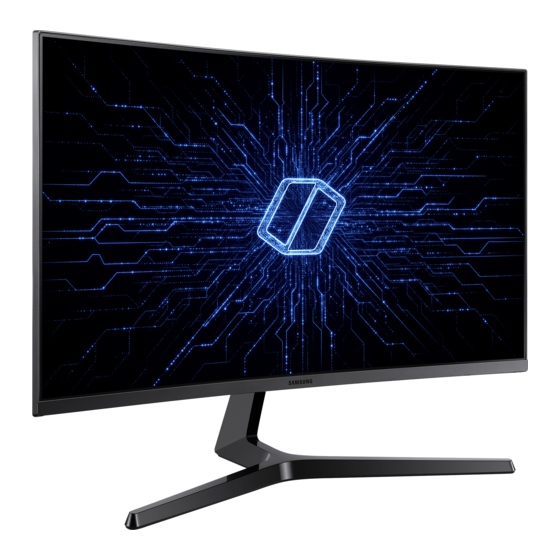
Table of Contents
Advertisement
USER MANUAL
Gaming Monitor
C*JG5*
The color and the appearance may differ depending on the product, and the specifications are subject to change without prior
notice to improve the performance.
The contents of this manual are subject to change without notice to improve quality.
© Samsung Electronics
Samsung Electronics owns the copyright for this manual.
Use or reproduction of this manual in parts or entirety without the authorization of Samsung Electronics is prohibited.
Trademarks other than that of Samsung Electronics are owned by their respective owners.
An administration fee may be charged in the following situations:
(a) An engineer is called out at your request, but it is found that the product has no defect (i.e., where the user manual
has not been read).
(b) You bring the unit to a repair centre, but it is found that the product has no defect (i.e., where the user manual has not
been read).
You will be informed of the administration fee amount before a technician visits.
Advertisement
Table of Contents

Summarization of Contents
Initial Setup and Safety
Installation, Storage, and General Safety
Guidelines for securing installation space, storage, and essential safety precautions.
Electrical Safety and Cleaning Procedures
Instructions for safe electrical usage and proper cleaning methods for the monitor.
Installation Warnings and Cautions
Critical warnings and cautions to follow during the physical installation of the monitor.
Safe Operation Guidelines
Safety warnings for operating the monitor, including handling, ventilation, and environmental factors.
Product Preparation and Setup
Monitor Controls and Navigation
Overview of monitor parts, control panel, and function key guide for menu access.
Adjusting Picture, Volume, and Ports
Guides for modifying brightness, contrast, sharpness, volume, and understanding monitor ports.
Physical Setup, Security, and Handling
Instructions for tilt adjustment, anti-theft lock, moving precautions, stand attachment/removal, and wall mounting.
Connecting Source Devices
Pre-connection Checks and PC Setup
Essential checks before connecting devices and guidance for PC connectivity via HDMI/DVI.
DP Connection and Audio Output
Instructions for connecting via DisplayPort and using headphones for audio.
Monitor Power Connection
Procedures for connecting the power adapter and turning the monitor on.
Cable Management Techniques
Methods for tidying and organizing cables connected to the monitor for a cleaner setup.
Ergonomics and Driver Installation
Correct Posture and Eye Care
Advice on maintaining proper posture and eye comfort during monitor use.
Installing Drivers and Optimizing Resolution
Steps for driver installation and setting optimal resolution/refresh rate for best performance.
Gaming Settings and Features
Picture Modes for Gaming Experience
Explains various picture modes designed to enhance gaming visuals.
Refresh Rate, Response Time, and Black Equalizer
Adjusting refresh rate, response time, and black levels for optimal gaming visuals.
FreeSync Technology Guide
Comprehensive guide on enabling and using FreeSync for tear-free gaming.
Low Input Lag and Screen Size Settings
Configuration options for reducing input lag and adjusting aspect ratio for various content.
Picture Settings and Enhancements
Picture Mode Selection
Choosing picture modes for different viewing environments and content types.
Core Picture Controls (Brightness, Color)
Adjusting fundamental picture elements like brightness, contrast, sharpness, and color tones.
Advanced Picture Enhancements
Utilizing features like MAGIC Upscale, Eye Saver Mode, and Screen Adjustment for visual quality.
OnScreen Display (OSD) Settings
Language and OSD Timeout Settings
Customizing OSD language and setting the automatic disappearance time for menus.
System Settings and Power Management
Volume and Power Saving Modes
Adjusting volume and managing power consumption with Eco Saving features.
Timer, Input, and DisplayPort Settings
Configuring Off Timer, PC/AV modes, and DisplayPort version for optimal input.
Source Detection and Input Recognition
Settings for how the monitor automatically detects and recognizes input signals.
Key Repeat, Power LED, and Reset Functions
Managing key repeat behavior, power LED status, and resetting settings to default.
Viewing System Information
Accessing information about the current input source, frequency, and resolution.
Installing Monitor Software
Easy Setting Box Software Guide
Instructions for installing Easy Setting Box for monitor partitioning and customization.
Installation Requirements and Issues
System requirements and potential problems encountered during software installation.
Troubleshooting and Problem Solving
Pre-Support Product Testing
Steps for self-diagnosis and verifying product functionality before contacting support.
Installation and Screen Display Problems
Solutions for common issues related to monitor installation and screen output.
Resolving Image Quality and Sound Issues
Troubleshooting steps for blurry images, color inconsistencies, and lack of sound.
Source Device and Video Playback Troubleshooting
Addressing problems with connected devices, choppy video playback, and audio synchronization.
Adjusting Frequency, Resolution, and Power Saving Modes
Guides for changing display frequency, resolution, and power-saving settings across Windows versions.
Monitor Technical Specifications
General Monitor Specifications
Comprehensive details on monitor size, display area, pixel pitch, and power requirements.
Plug-and-Play and Pixel Characteristics
Information on monitor compatibility, pixel behavior, and environmental considerations.
Standard Signal Mode Compatibility
A table detailing supported signal modes, frequencies, and resolutions for different inputs.
Appendix: Support and Service Information
Service Costs and Customer Responsibilities
Information on service fees, warranty exclusions, and customer-induced damages.
Product Defect and Damage Clarifications
Clarifies what constitutes a product defect versus customer fault or external damage.
















Need help?
Do you have a question about the C32JG54QQ Series and is the answer not in the manual?
Questions and answers